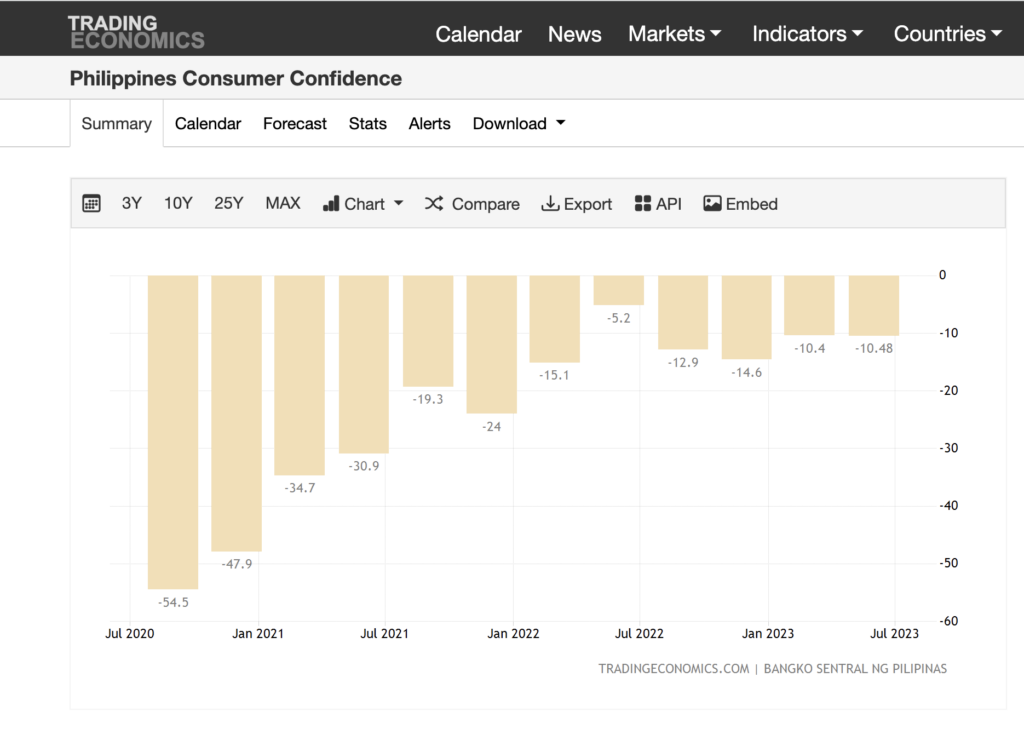In the dynamic world of economics, tracking the pulse of a nation’s financial health and the sentiments of its people is crucial. The Philippines, a country that has been making remarkable strides in economic growth, offers us an intriguing case.
One of the key indicators that allow us to gauge the mood of its people regarding their economic standing is the Confidence Index, akin to the Consumer Confidence Index in the United States. In this article, we delve into the Philippines’ economic journey, the significance of the Confidence Index, and the intriguing contrast between its economic growth and the people’s perceived confidence.
The Enigma of Economic Growth
The Philippines recently achieved a significant milestone by crossing the $400 billion GDP marker. However, this achievement was not met with the jubilation one might expect. Instead, the Confidence Index registered a rather disheartening -15.1 in Q1 2022, indicating a prevailing sense of pessimism among the population. This raises a pertinent question: How can a country with such impressive economic growth witness such a decline in confidence?

Understanding GDP and Economic Growth
Before delving further into this paradox, let’s clarify the concept of Gross Domestic Product (GDP). It encompasses all economic activities within a country, from daily transactions to government investments. In 2017, the Philippine economy was valued at around $328 billion. Fast forward to the close of 2022, and we find ourselves in the $400 billion territory. This remarkable growth, albeit with a hiccup during the pandemic, underscores the vitality of the Philippine economy.
COVID-19 and Economic Resilience
The COVID-19 pandemic did take its toll, causing a temporary dip in GDP. In 2019, the Philippine economy was nearly $380 billion but dipped to around $361 billion in 2020 due to lockdowns and economic disruptions. However, the resilience of the nation shone through in 2021 as the GDP bounced back to $394 billion, a promising sign of recovery. In 2022, it reached $400 billion, with further growth on the horizon.
The Confidence Index Dilemma
Now, let’s return to the enigma of the Confidence Index. Despite this impressive economic growth, the Confidence Index remained firmly in pessimistic territory. In Q1 2022, it was recorded at -15.1, following previous negative scores of -24 and -13.8. The question is: Why?
Several factors could explain this paradox. It’s essential to consider that while the overall economy may be thriving, individual experiences can vary widely. People might be grappling with inflation, job insecurity, or concerns about the distribution of wealth. These individual experiences can significantly influence their confidence in the economy.
More People Are Buying Cars
While many people complain about their financial struggles, it’s interesting to know that car sales in our country continue to increase. The remarkable year-on-year growth in total vehicle sales in the Philippines, exemplified by the 2017 figure of over a quarter of a million cars sold nationally, indeed reflects the country’s economic progress and the rising living standards of its people. However, this surge in car ownership comes hand-in-hand with a pressing challenge: the exacerbation of heavy traffic conditions. As the number of vehicles on the road continues to climb, congestion worsens, causing not only frustratingly long commutes but also escalating fuel consumption and environmental concerns.
Nevertheless, this situation presents an opportunity for the Philippines to leverage its economic growth for the benefit of its citizens. It underscores the importance of a well-balanced approach, one that promotes efficient public transportation systems and emphasizes sustainable urban planning. By doing so, the country can address the issue of heavy traffic while still ensuring individual mobility. Economic growth should not only signify prosperity but it should also enhance the lives of the people through better traffic management and urban development.
The Philippines presents an intriguing case study of the complex relationship between economic growth and public sentiment. While our nation has achieved remarkable economic milestones, the people’s confidence, as reflected in the Confidence Index, remains a cause for concern. Understanding this dichotomy is essential for policymakers, economists, and business leaders to ensure that the benefits of economic growth reach all sectors of society.
As the country continues its journey towards economic prosperity, bridging the gap between impressive GDP figures and the Confidence Index will be a key challenge. It will require concerted efforts to address the concerns and needs of the population, ensuring that economic growth translates into tangible improvements in our lives.

